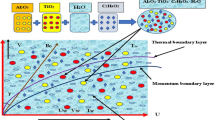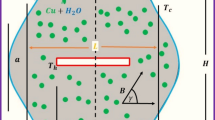Abstract
Combined formulation developed for the fluid-particle mixture is introduced to simulate the biocube-fluid mixture flow, which is utilized for sewage disposal. Some tricky boundary conditions are introduced in order to simulate the effect of screen wall and air bubble, which is injected from the bottom of sewage reservoir. It has been shown that a circulated flow pattern, which was observed in experiment, is reproduced from the present numerical simulation. Furthermore, the effect of biocube density on the distribution pattern of biocube is also studied. It has been shown that a biocube whose density is slightly smaller than that of surrounding fluid or neutrally buoyant one are optimal for the uniform distribution of biocube.
Similar content being viewed by others
Abbreviations
- a ij :
-
Coefficient associated with u-velocity of fluid in combined formulation
- b ij :
-
Coefficient associated with υ-velocity of fluid in combined formulation
- c ij :
-
Coefficient associated with pressure in combined formulation
- C d :
-
Drag coefficient
- e x,e y,e z :
-
Unit vector in x, y, z direction
- F drag :
-
Drag
- g :
-
Gravity
- G :
-
External force
- H 1 :
-
A function space which has the square integrable first derivative
- I:
-
Identity matrix
- I :
-
Moment of inertia
- L 2 :
-
A space which has the square integrable function
- m :
-
Mass of a biocube
- M :
-
Matrix associated with the motion of a biocube
- p :
-
Pressure
- R :
-
Radius of air-bubble
- Tr :
-
Traction acting on a biocube
- u :
-
x-component of fluid velocity
- U :
-
Biocube velocity
- \(\vec U_p \) :
-
Translation velocity of biocube
- \(\vec u\) :
-
Fluid velocity
- \(\vec u_m \) :
-
Mesh velocity
- υ:
-
y-component of fluid velocity
- \(\vec x\) :
-
Position vector of a point on a biocube surface
- \(\vec X_c \) :
-
Position vector of the mass center of a biocube Greek Symbols
- μ:
-
Viscosity
- ρ:
-
Density
- τ:
-
Viscous stress
- Г:
-
Boundary
- Ω:
-
Angular velocity of bicube
- T :
-
Transpose
- n :
-
Time step
- p :
-
Particle (Biocube)
- g :
-
Dirichlet boundary condition
- w :
-
Surrounding fluid
References
Ahn, S. W., Lee, B. C., Kim, W. C., Bae, M. W. and Lee, Y. P., 2002, “Characteristics of Fluid Flow and Heat Transfer in a Fluidized Heat Exchanger with Circulating Solid Particles,”KSME International Journal, Vol. 16, No. 9, pp. 1175–1182.
Choi, H. G., 2000, “Splitting Method for the Combined Formulation of Fluid-Particle Problem,”Comput. Methods. Appl. Engrg., Vol. 190, pp. 1367–1378.
Choi, H. G. and Joseph, D. D., 2001, “Fluidization by Lift of 300 Circular Particles in Plane Poiseuille Flow by Direct Numerical Simulation,”J. Fluid Mech., Vol. 438, pp. 101–128.
Glowinski, R., Pan, T. W., Hesla, T. I. and Joseph, D. D., 1999, “A Distributed Lagrange Multiplier/Fictitious Domain Method for Particulate flows,”Int. J. Multiphase Flow, Vol. 25, pp. 755–794.
Hesla, T., 1990, “Combined Formulation for Fluid-Particle Mixture,” unpublished note.
Hu, H.rH., 1996, “Direct Simulation of Flows of Solid-Liquid Mixture,”Int. J. Multiphase Flow, Vol. 22, pp. 335–352.
Kim, D. W., 2002, “Improved Convective Heat Transfer Correlations for Two-Phase Two-Component Pipe Flow,”KSME International Journal, Vol. 16, No. 3, pp. 403–422.
Kolon Engrg. & Construction Co., 2001, “Environmental New Technology No. 18: Sewage treatment system using biocube,”Issued by Environmental Management Corporation, WWW html document, address http://www.emc.or.kr/ english/koetv/verification (box.htm
Lim, T. W. and Han, K. I., 2003, “A Study on Pressure Drop Characteristics of Refrigerants in Horizontal Flow Boiling,”KSME International Journal, Vol. 17, No. 5, pp. 758–765.
Nam, Y. S., Choi, H. G., and Yoo, J. Y., 2002, “AILU Preconditioning for P2P1 Finite Element Formulation of the Incompressible Navier-Stokes Equations,”Comput. Methods. Appl. Engrg., Vol. 191, pp. 4323–4339.
Sussman, M., Smereka, P., and Osher, S., 1994, “A Level set Approach for Computing Solutions to Incompressible Two-Phase Flow,”J. Comput. Phys., Vol. 114, pp. 146–159.
Van der Vorst, H. A., 1992, “Bi-CGSTAB: a Fast and Smoothly Converging Variant of Bi-CG for the Solution of Non-Symmetric Linear Systems,”SIAM J. Sci. Statist. Comput., Vol. 12, pp. 631–644.
Author information
Authors and Affiliations
Corresponding author
Rights and permissions
About this article
Cite this article
Choi, Hg., Lee, Mh. & Yong, H.T. Simulation of biocube-fluid mixture using combined formulation. KSME International Journal 18, 1418–1427 (2004). https://doi.org/10.1007/BF02984255
Received:
Revised:
Published:
Issue Date:
DOI: https://doi.org/10.1007/BF02984255




